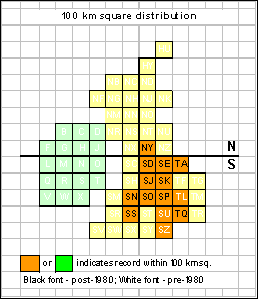Uncommon in England and Wales.

- Number of pre-1980 records = c.10
- Number of post-1980 records = c.20
Existing records indicate that S. stigmaticus is widespread in England though it is progressively more localised further north and is absent from Scotland. There are no records for Ireland.
S. stigmaticus occurs at higher latitude in Finland than Scotland and there does not seem to be any reason why it could not occur at least in lowland Scotland. Its absence from Scotland (and Ireland) strongly suggests that the species is an introduction that has not yet attained its potential range. Some species which previously had restricted distributions (e.g. Ectopsocus briggsi) are now widespread throughout Britain and Ireland which raises the question why the distribution of S. stigmaticus is limited. The results of Tim New’s (1969) studies of the catches of airborne psocids in suction traps at Silwood Park in Berkshire provides evidence which may account for this. The seven year study (1961-7) showed that the majority of species occurring at the site would occasionally fly and some (including E. briggsi) flew regularly, often at particular times of the year. Although S. stigmaticus occurred in good numbers at the site no specimens were caught in the traps over the seven year study period. If this unwillingness to fly is a general tendency (i.e. was not due to the particularly conditions at Silwood Park) it would provide a significant impediment to the spread of the species and would go some way to explaining a slow dispersion rate.
The earliest specimens held in British museum collections are located in the Natural History Museum, London. These specimens indicate that S. stigmaticus occurred in Britain a good deal earlier than the first published records. 19th century specimens were primarily collected by Robert McLachlan and were all found in the outskirts of London. The earliest was collected near Reigate, Surrey on 5th July 1872. It may be the case that London was the introduction point of the species in Britain but this argument is weakened by the fact that McLachlan lived in London.
Summary: has been found mainly on deciduous tree and bush branches (no records from trunks).
Associations:
- Deciduous branches: alder, apple, ash, blackthorn, elder, hawthorn, horse chestnut, plum, sallow and willow.
- Conifer/evergreen branches: cypress family and pine.
Sampling techniques: beating branches.
New’s study (1970) of the occurrence of psocids on different tree species at Silwood Park showed that S. stigmaticus occurred almost exclusively on hawthorn even though a wide range of other broad-leaved and coniferous trees were present. He reported that S. stigmaticus was often confined to one or two tree species, but that the trees concerned were different in the various published accounts. He concluded that the differences in the distributions between tree species in a given area may depend to a large extent on characters of the different trees in the area. He pointed out that there is a need to understand the underlying mechanisms affecting the relative numbers on different tree species.
New, T.R. 1969. Aerial dispersal of some British Psocoptera, as indicated by suction trap catches. Proceedings of the Royal Entomological Society of London (A) 44: 49-61.
New, T.R. 1970. The relative abundance of some British Psocoptera on different species of trees. Journal of Animal Ecology 39: 521-540.